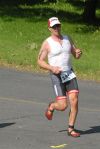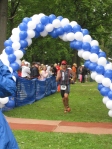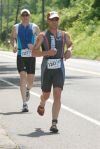I've been hitting the trails
my whole life and running for over 35 years, and running trails for over 30
years. I've gained a lot of experience over the years and I pretty well qualify
as above average when it comes not just to running, but to running trails.
There isn't much I haven't encountered or dealt with, yet I recently received a
reminder that I'm not perfect.
A friend of mine recently
completed his first Ironman (140.6, the real deal) and is looking for his next
challenge. This summer he also read Scott Jureck's book "Eat to Run",
and he is now looking to do his first ultra with a long range goal of running a
100+ mile ultra some day. He knows I've done three 50k's and am looking to do a
50 mile within the next year. So, he invited me along when he planned to do his
first 50k. Unfortunately the race was already closed, but undeterred he decided
we should just do a 30 mile trail run in its stead. I agreed and less than two
weeks later we inked in to run.
He got online and started
looking at a trail and figuring out logistics. He quickly decided on the
Appalachian Trail and found a place where we could start which would have us
hitting a gas station 5 miles later, and a place to park his car with supplies
5 miles beyond that. The plan was to drop off his car and take my truck back to
start point. We were to run 15 miles out (15.6 actually, he wanted 50k) and
then turn back. With the gas station and his car we would have "aid
stations" at 5, 10, 20, and 25 mile marks. Everything sounded perfect,
except one teeny, tiny, thing. Neither one of us had ever seen the section of
trail we were going to run.
Morning of the run came and
he drove over to my house. I then followed him through the narrow, winding mountain
roads to where we were going to drop his car. It was still dark and we didn't
know exact spot where trail intersected road. After driving a while and knowing
that we were getting close we found the spot where a trail hit the road and
parked his car. I dropped off my supplies in his car, conferred with him about
what he had and then we headed to out start area. By the time we got to our
start point it was light enough for us to begin, so we geared up and set out.
I have to admit, that despite
his having a fairly well thought out plan and course I did have some
apprehensions. The first and foremost was the terrain that we would face. I
didn't care about the ascents and descents, I knew they'd be there and they'd
be long and steep, I was concerned about the trail itself. I had some fear that
trail could be so rocky that running could be virtually impossible. In
addition, we had a lot of rain recently, and who knows what that could have
done to the trails.
Anyway, after putting on our camelbacks, off we went. We had
about 100 yards on the road until we hit the trail, and were quickly there.
Unfortunately, one of my fears was already showing its ugly head. The trail was
immediately too rocky to run. The trail was nothing but rocks, some loose, some
not, some suspect, but not runable. In all fairness, it was also a very steep
climb that we may have walked anyway to save our legs for the run ahead. We
slogged our way to the top, and got some sketchy, but runable trail and took
off.
Back in the early spring I
started developing some problems with my right hip. I went through bouts of
better and worse through the rest of the spring, all of the summer and into the
start of the fall. I was starting to feel better, but going into the run I was
concerned it may not hold up, and within first mile I found out that it
wouldn't. Our first downhill I slipped and came down hard on the heel of that
same leg. I immediately felt a sharp, searing pain in my hip, and quickly lost
strength in that hip. I could run, with little pain, but I wasn't able to lift
knee of that leg as high, and that would quickly prove a problem.
The trail continued to be
very rocky, and impossible to run in many places. It got to the point where we
were desperate to run and we were running every possible opportunity. Unfortunately,
since I was having trouble lifting my right leg, I was catching more and more
rocks and roots with my toes and aggravating the hip further. I could have
turned back, but I'm not that smart and it goes against my deepest beliefs,
keep running until you can't.
After over an hour of running
we reached the gas station that marked the five mile point in the run. We
stopped for a few minutes while Doug (Jr as I refer to him) got something to
eat. We both grabbed a quick drink as well and continued on.
The trail didn’t get any easier,
and if anything actually got harder. The footing was horrible and we had some
pretty steep ascents and descents. It resulted in us doing a lot of walking and
slow jogging, but when we hit a decent stretch of trail Jr would take off. I
did my best to hold on to him during those stretches. For the most part I was
holding close to him, but it got harder and harder to do with each passing
mile. I found myself focusing on just making it to the 10 mile mark and his
car. I wasn’t going to quit, but I couldn’t look any further ahead than that
point, or I would start the negative downward spiral mentally.
Almost two hours after
leaving the gas station we finally reached the road where Jr had parked his
car. Unfortunately, the trail didn’t cross the road where we thought it did,
but it was close enough. We only had about 100 yards on the road to get to his
car, where we pulled out our stash of food and drink. While refueling we
discussed how long it had taken for us to reach that point, how far we had left
to go, and terrain that we would most likely encounter. We quickly came to
realization that instead of the 6-7 hour run we had thought we were going to
do, that it was more likely going to be well over 10 hours. This was more time
than either of us really wanted to put into the run, and to my relief, Jr
agreed that we should turn back.
A few more minutes of rest,
food, drink and foam roller and we started back the way we came. I had
tightened up pretty good during that stop and really started to struggle to
keep up. Jr was running strong, and now that he knew we weren’t going 30 miles,
but rather only 20 miles which he’d done before (though not on trails), he
started pushing the pace. I was struggling to lift my right foot enough to
clear the rocks and roots so I wouldn’t trip or injure him further. As a
result, I wasn’t paying as much attention as I should have been on where I was
stepping with my left foot. I was only concerned with getting enough lift with
my right.
About 2 ½- 3 miles into the
return I paid the price for my inattention to my footing. As I was swinging my
left leg through I smashed my pinky toe into a large rock, and the momentum of
my foot and leg kept them traveling forward. Unfortunately my pinky toe
remained with the rock (remember, I wear Vibram Five Fingers). The toe was
forcefully ripped to the side and I felt an immediate sharp burning pain sear
through my foot. I’ve stubbed many a toe over the years, and some of them very
hard, but I knew instantly that this wasn’t a stub. It was broken. Plain and
simple, there was no doubt in my mind, I broke my toe.
Despite the quick eruption of
pain in my left foot, and the shout of pain that escaped me, I kept running. Jr
heard me, glanced back, saw that I was still running and so he continued on not
knowing what I just did. We still had over 7 – 7 ½ miles left to get back to my
truck. I could have stopped and turned back for Jr’s car, but we had already
shortened the run, I didn’t want to totally kill it for him, so I kept running.
The rest of the run was just
a painful blur. I could no longer push off on my left foot, and could lift my
right. This resulted in me catching my right foot more and more often on roots
and rocks. Each time that I did so, the hip got a little bit worse. And,
because of how rocky the trail was, I kept banging and catching my broken toe
on other roots and rocks, most of which with healthy toe wouldn’t have been
that bad, but were now causing me a good deal of pain. After what seemed an
eternity to me, we reached the gas station again, which meant only 5 remaining
miles to run.
We both got something to eat
and drink while we were at the gas station. Jr inquired about my hip, and I
told him it hurt, but I’d make it. I decided not to tell him about the toe just
yet. I didn’t want him to try getting me to stay at the gas station while he
went for truck, or to cause him to quit the run. It is just a pinky toe after
all, and though it was painful, and I could tell very swollen, it wasn’t going
to kill me. I’d been struggling to keep within visual range of him on the good
sections of trail, and was taking some risks to try and catch back up on the
bad, but I thought I could make the remaining distance without slowing him too
much. So when he was ready to run again, so was I.
Not really much to say about
the remaining 5 miles beyond that it got harder and harder for me and I kept
falling further and further back. He started waiting for me at start of each of
the bad sections and once I caught up, he’d start off again. Finally, with about
1 ½ miles left I confessed what had happened to my toe after he’d had a lengthy
wait for me to catch up to him. I told him to go ahead and I’d be along as soon
after him as I could. He refused to go and kept waiting for me, and so we very
slowly covered the remaining distance. When we got back to road that my truck
was parked on, he smoothly accelerated down the road the short distance to the
truck. I was able to run a slow hobble behind him.
On the day mistakes were
made, but things were also done right. It is always good to either scout the
trail you plan to run, or get a good description from someone who knows. You
can head into it blind, but may find yourself doing very little running as we
did. Also, I probably shouldn't have attmepted anything like that until I knew
my hip was fully recovered and healed. Trail running is much more strenuous
than running on roads. However, we were smart enough to run with a partner in case
something happened. Jr had done an excellent job of figuring out logistics for
keeping us fueled and hydrated. We had our cell phones with us, and we were
smart enough to turn back (well, at least Jr was) when we knew trail was going
to be too much for us to do the distance we had planned.
After the run, instead of
letting me lick my wounds, my wife had me out digging a new garden. Pinky toe and hip
aren't that important...
Oh, and thanks to Doug, aka Jr, whose pictures I stole for the post...
Oh, and thanks to Doug, aka Jr, whose pictures I stole for the post...


































